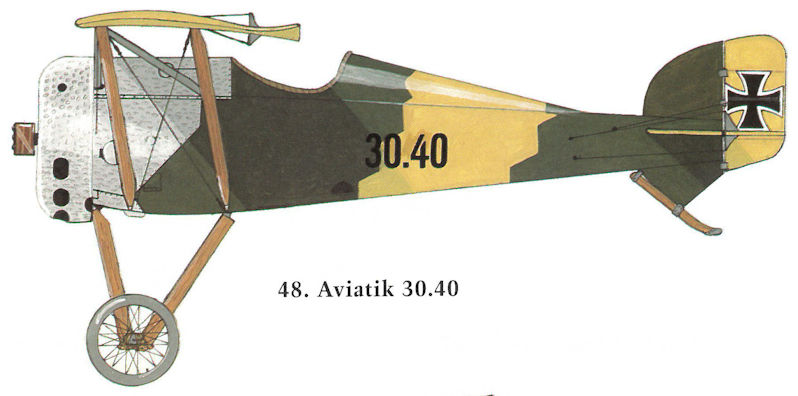W.Green, G.Swanborough The Complete Book of Fighters
AVIATIK (BERG) 30.40 Austria-Hungary
A parasol monoplane derivative of the Aviatik 30.27, the Aviatik 30.40 was powered by a similar 160 hp Steyr Le Rhone 11-cylinder rotary engine, and only one prototype was built and flown during the summer of 1918. The Aviatik 30.40 was of wooden construction. The forward fuselage was covered by light metal panels and the remainder of the fuselage was ply covered. The wing had fabric skinning, and steel-tube bracing struts were employed.
Max speed, 119 mph (192 km/h).
Time to 3,280ft (1000m), 1.5min, to 6,560ft (2 000m), 2.83 min., to 9,840 ft (3 000 m), 6.83 min.
Empty weight, 807 lb (366 kg).
Loaded weight, 1,292 lb (586 kg).
P.Grosz, G.Haddow, P.Shiemer Austro-Hungarian Army Aircraft of World War One
Aviatik 30.40
The Aviatik 30.40 prototype, powered by a 150 hp Le Rhone(St) rotary engine, was Aviatik's most ambitious effort to meet the interceptor requirement. Weighing only 586 kg (1292 lb) fully loaded, it was the lightest fighter built in Austria-Hungary. The airframe was derived from the 30.27 biplane, and the strut-braced parasol wing had been thoroughly tested on the Aviatik D.II. Based on promising performance recorded during trials in July and August 1918, the 30.40 was proposed for production by Thone & Fiala. But until the supply of Voltol was assured, the LFT was forced to exclude the rotary-engined fighter from further consideration. In late October 1918, the 30.40 was pro-forma accepted to enable Aviatik to receive payment for the aircraft.
Aviatik 30.40 Specifications
Engine: 150 hp Le Rhone (St)
Wing: Span Upper 7.30 m (23.95 ft)
Total Wing Area 10.5 sq m (113 sq ft)
General: Length 5.35 m (17.55 ft)
Empty Weight 366 kg (807 lb)
Loaded Weight 586 kg (1292 lb)
Maximum Speed: 192 km/hr (119 mph)
Climb: 1000m (3,281 ft) in 1 min 30 sec
2000m (6,562 ft) in 2 min 50 sec
3000m (9,843 ft) in 6 min 50 sec
4000m (13,124 ft) in 10 min
5000m (16,405 ft) in 16 min 50 sec
6000m (19,686 ft) in 22 min
Aviatik 30.42
The Aviatik 30.42 prototype was reported in "good condition" in the Aviatik hangar at Aspern on 7 October 1918. Since it is listed jointly with the 30.27, 30.31 and 30.32 prototypes, the 30.42 also may have been a rotary-engined biplane fighter but confirmation is lacking. In late October, the 30.42 was pro-forma accepted to enable Aviatik to receive payment for the aircraft.
E.Hauke, W.Schroeder, B.Totschinger Die Flugzeuge der k.u.k. Luftfahrtruppe und Seeflieger 1914-1918
30. Flugzeuge der Österreichischen Aviatik-Werke Wien, Stadlau
30.40 Berg D Prototyp mit Parasolflügel St 160
 |
P.Grosz, G.Haddow, P.Shiemer - Austro-Hungarian Army Aircraft of World War One /Flying Machines/
|
| Aviatik 30.40
|
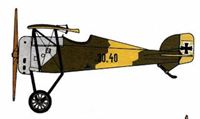 |
E.Hauke, W.Schroeder, B.Totschinger - Die Flugzeuge der k.u.k. Luftfahrtruppe und Seeflieger 1914-1918
|
| Aviatik-Berg D 30.40 Prototyp
|
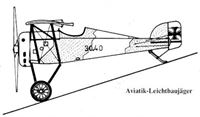 |
E.Hauke, W.Schroeder, B.Totschinger - Die Flugzeuge der k.u.k. Luftfahrtruppe und Seeflieger 1914-1918
|
| Aviatik-Leichtbaujager
|
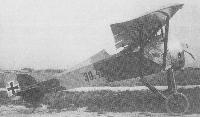 |
W.Green, G.Swanborough - The Complete Book of Fighters
|
The Aviatik (Berg) 30.30 was developed for high altitude combat over the Italian front.
The Aviatik 30.40 was the only Berg-designed fighter monoplane
|
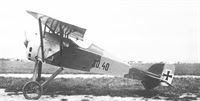 |
P.Grosz, G.Haddow, P.Shiemer - Austro-Hungarian Army Aircraft of World War One /Flying Machines/
|
The Aviatik 30.40 parasol fighter during flight trials at Aspern in July and August 1918. Armament would have consisted of two Schwarzlose machine guns mounted at eye level.
Aviatik 30.40, Versuchsflugzeug mit Parasoltragfläche, Umbau aus Berg 30.27, mit Steyr Rh 160 PS
Aviatik 30.40, экспериментальный самолет с крылом-парасоль, переоборудованный из Berg 30.27, со Steyr Rh 160 л.с.
|
 |
E.Hauke, W.Schroeder, B.Totschinger - Die Flugzeuge der k.u.k. Luftfahrtruppe und Seeflieger 1914-1918
|
Aviatik 30.40. Heckansicht, vereinfachtes Tarnschema
Aviatik 30.40. Вид сзади, упрощенная схема камуфляжа
|
 |
P.Grosz, G.Haddow, P.Shiemer - Austro-Hungarian Army Aircraft of World War One /Flying Machines/
|
| Aviatik 30.40. The washed-out ailerons, a typical Berg feature, are clearly in evidence. Although the photograph was taken in the summer of 1918, the old-style markings have not been replaced.
|
 |
P.Grosz, G.Haddow, P.Shiemer - Austro-Hungarian Army Aircraft of World War One /Flying Machines/
|
| Aviatik 30.40
|

